Tortoise Eye Infection Unveiled: Causes, Symptoms, Treatment, and Prevention
Tortoises’ well-being is a top priority as pets, so it’s crucial to be educated about various health issues they may face. One such common problem is eye infection. It is not only painful for our shelled friends but can also escalate into serious complications if not treated timely.
There are several types of tortoise eye infections, including conjunctivitis, Hypovitaminosis A, cataracts, eye injuries, etc. They can be caused due to several reasons, including poor habitation, dietary issues, lack of UVB lighting, etc.
Research has shown that neglecting symptoms can lead to complications and, in some extreme cases, blindness in tortoises. For a deep dive into research concerning eye health in reptiles, including tortoises.
What is a Tortoise Eye Infection?
Contents
An eye infection in tortoises occurs when harmful bacteria or other microorganisms invade the eye area, causing symptoms like redness, swelling, and discharge. These infections can become a severe issue if not addressed timely.
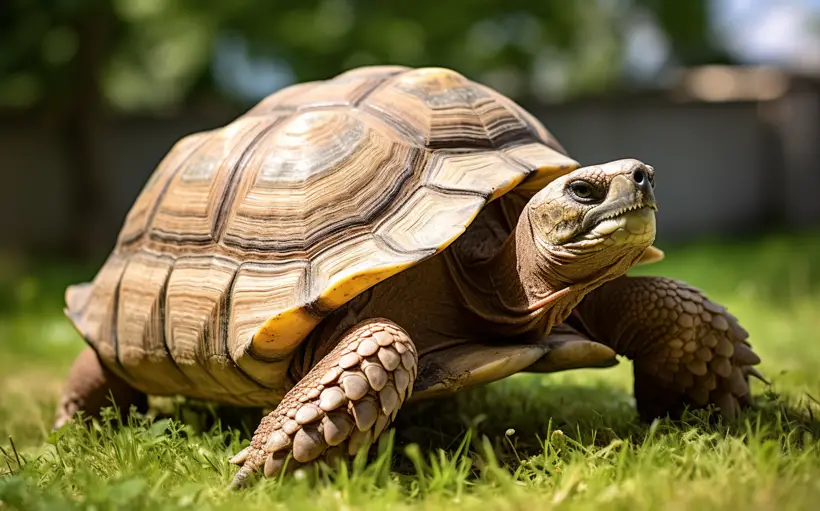
Types of Tortoise Eye Infections: Causes, Symptoms, and Treatment
There are different types of eye infections that can occur in tortoises. Each of them has different reasons as well. To treat them well, you have to learn the type of infections that can happen and their underlying causes.

1. Conjunctivitis
The tortoise’s conjunctiva (the mucous membrane that lines the inside of the eyelids and the surface of the eye) may become inflamed, a condition known as conjunctivitis. When it manifests in a tortoise, this ailment is generally referred to as “pink eye” and may affect either eye.

Causes of Conjunctivitis:
- Poor habitat conditions
- Exposure to irritants like dust or chemicals
- Bacterial or viral infections
- Lack of UVB lighting
Symptoms of Conjunctivitis:
- Red or pink eyes
- Swollen eyelids
- Excessive tearing
- White or yellow discharge
Treatment of Conjunctivitis:
- Cleaning the eyes with saline solution
- Topical antibiotic ointments specifically for reptiles
- Adjusting habitat conditions like humidity and lighting
- Veterinary consultation
2. Hypovitaminosis A
Deficiency in vitamin A is known as hypovitaminosis A. It is a fat-soluble vitamin necessary for eyesight, cell development, and immunological function. Inadequate vitamin A levels in the body are a typical cause of this term’s usage.
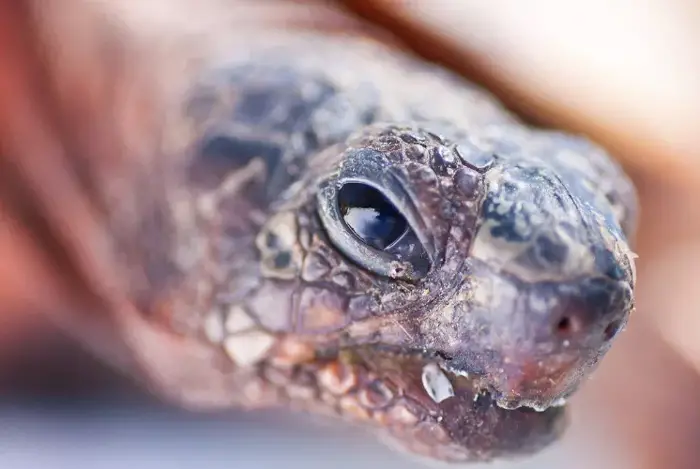
Causes of Hypovitaminosis A:
- Inadequate diet lacking in vitamin A-rich foods like carrots
- Poor husbandry
- Lack of UVB lighting
Symptoms Hypovitaminosis A:
- Swollen eyes
- Dry, scaly skin
- Poor growth rates
- Lethargy
Treatment Hypovitaminosis A:
- Vitamin A injections administered by a vet
- Incorporating vitamin A-rich foods into the diet
- UVB lighting and heat source adjustment
3. Cataracts:
Cataracts cause blurred vision due to clouding of the crystalline lens located within the eye.
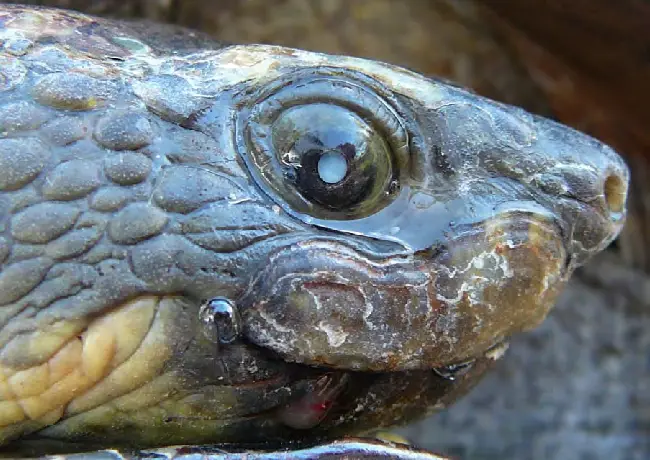
Causes of Cataracts:
- Aging
- Exposure to extreme light or UVB radiation
- Trauma to the eye
Symptoms of Cataracts:
- Cloudy or opaque appearance of the eyes
- Difficulty navigating the environment
- Reduced activity
Treatment of Cataracts:
- Surgical removal of the cataract (in severe cases)
- Managing lighting conditions and keeping the lights to an optimal level to prevent further damage
- Veterinary consultation
4. Tortoise Eye Injury:
When a tortoise sustains any kind of physical harm to its eye, we call it a tortoise eye injury. Tortoise eye injuries may range from being somewhat irritating to potentially life-threatening disorders that need surgery.

Causes of Eye Injury:
- Scratches from substrate or decorations in the enclosure
- Fights with other tortoises
- Foreign objects
- Improper handling
Symptoms Eye Injury:
- Redness and swelling
- Discharge
- Squinting or wincing
- Inactivity or reluctance to eat
Treatment Eye Injury:
- Immediate veterinary attention
- Antibacterial or anti-inflammatory eye drops
- Possible pain relief medication such as buprenorphine or butorphanol.
- Adjusting enclosure to minimize hazards
When to Seek Professional Help?
Knowing when to seek professional help can be the difference between a quick recovery and a prolonged, complicated issue for your tortoise. Mild symptoms may tempt you to try over-the-counter remedies. It’s essential to consult with an experienced veterinarian as soon as possible.
Iff the following conditions happen, please consult a vet as soon as possible.
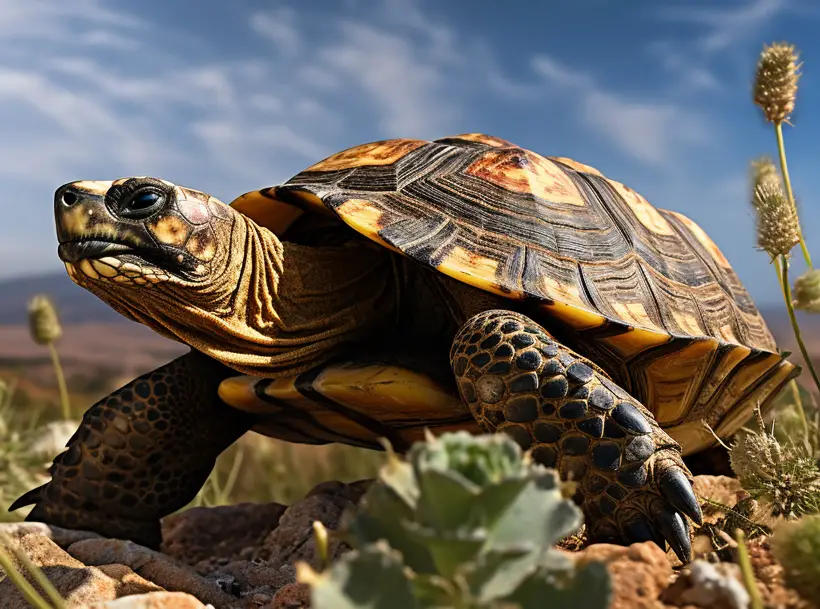
Persistent Symptoms
If you have attempted basic cleaning or applied saline drops and yet notice that the symptoms persist or worsen after a couple of days, don’t wait. Consistent signs of eye discomfort, such as swelling, discharge, or redness, are clear indications that professional help is needed.
Escalating Conditions
Eye infections can escalate into more severe conditions, including ulcerations or even vision loss, if not addressed in a timely manner. At this point, your tortoise may suffer from significant discomfort and display altered behavior like reduced activity or refusal to eat.
The longer you wait, the more difficult and costly the treatment can become. If left untreated, these complications could even result in permanent damage.
How is a Tortoise Eye Infection Diagnosed?
Ophthalmic diagnostic procedures include summer and winter bacterial flora culture. Schirmer tear test (STT) and endodontic absorbent paper point tear test (EAPPTT) at 32 °C and 18 °C, respectively. Also, cytology of conjunctival cells including B-mode ultrasonography. Adding to it, measurement of palpebral fissure length (PFL) and applanation tonometry (in two positions). These procedures help to diagnose eye infections in tortoises.
Watch the following video to learn how tortoises’ eye infections are diagnosed.
Steps to Administer Eye Drops for Your Tortoise
- Wash your hands thoroughly.
- Hold your tortoise gently but firmly.
- Apply the eye drop to the infected eye.
- Release your tortoise and let it blink the medicine into the eye.
How To Prevent Tortoise Eye Infections?
An ounce of prevention is worth a pound of cure. Take these steps to minimize the risks:

Proper Cleaning
Sanitize your tortoise’s living area regularly. Maintaining a clean habitat is crucial for preventing bacterial and viral infections, including eye infections.
Steps:
- Remove waste daily.
- Disinfect the enclosure at least once a week with reptile-safe cleaners.
- Regularly clean and replace water dishes and food trays.
Tip: Ensure that the habitat is well-ventilated but not too drafty, as both extreme humidity and excessive dryness can contribute to eye issues.
Balanced Diet
Ensure your tortoise gets all the essential nutrients, particularly vitamin A. Incorporate a variety of leafy greens, vegetables, and fruits that are high in vitamin A, such as carrots, sweet potatoes, and kale.
You can also consider reptile-specific vitamin supplements after consulting with a vet.
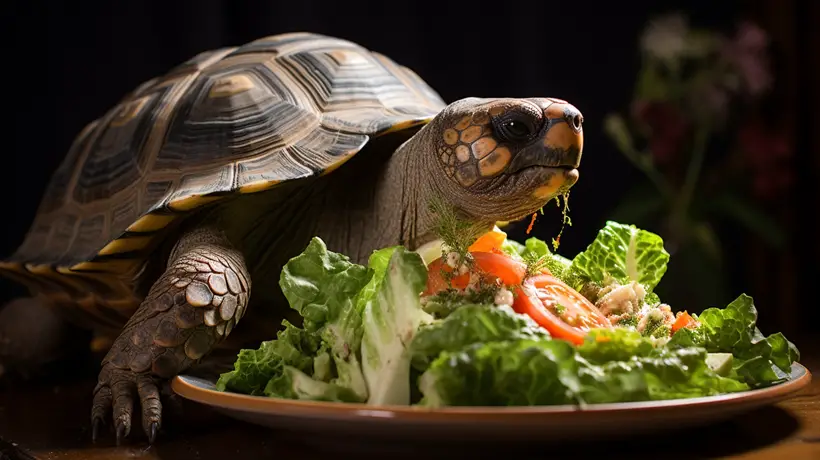
Tip: Don’t over-rely on supplements. Natural food sources are usually better assimilated and offer other nutrients, too.
Regular Vet Visits
Routine check-ups can identify issues before they become significant problems. Schedule regular check-ups with a vet experienced in reptile care at least once or twice a year.
If you notice any signs of eye issues like redness, swelling, or discharge, make an appointment sooner.
Tip: Keep a health journal for your tortoise. Record eating habits, activity levels, and any noticeable changes in appearance or behavior. This information can be very useful for the vet.
FAQs
Here are some of the most asked questions regarding tortoise eye infections.
It’s important that your turtle has clean, sparkling eyes. They shouldn’t have any signs of discharge since it might indicate an infection. On the other side, dehydration may be present if their eyes are overly dry.
In order to replenish its vitamin A stores, the turtle has to consume meals rich in the nutrient. Vitamin A is found in abundance in dark, leafy greens like dandelion greens.
Conclusion
Eye infections in tortoises are more common than one might think, but the good news is that they are also highly treatable. Awareness is the first step toward ensuring your tortoise’s eye health.
By being vigilant for symptoms and taking preventive steps, you can significantly reduce the risks. Remember, prompt action can make all the difference in the world. The sooner you identify and start treating the infection, the easier it is to manage and cure. For a list of qualified reptile vets in your area.

